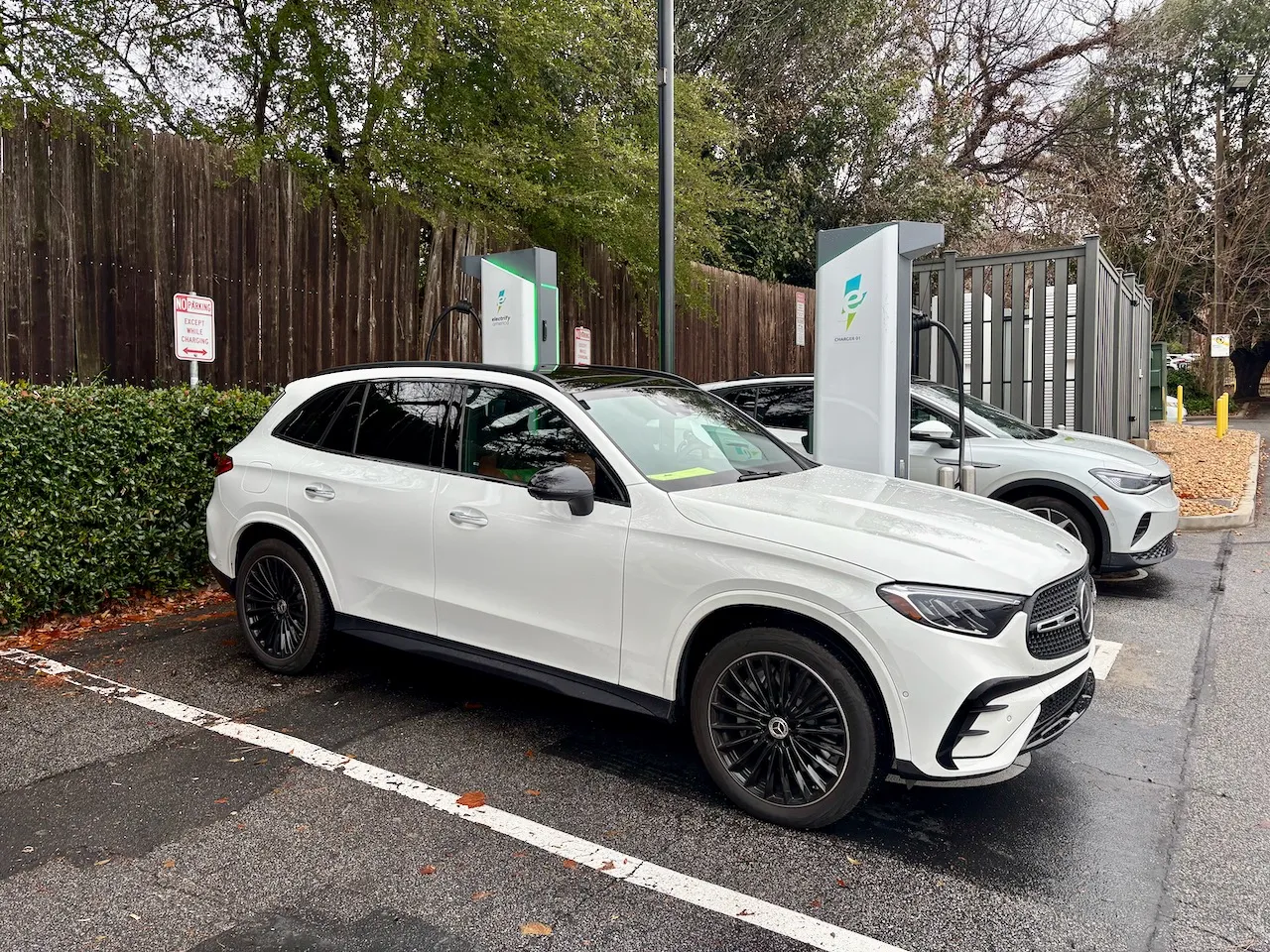Plug-in hybrids are building their case as stopgap solutions for drivers not ready to take the EV plunge. Those of you who can control or limit your daily driving needs are squarely in its sights. Do you keep your daily duties at 50 miles or less? The Benz GLC 350e has you covered.
A home-charging setup for off-peak parsimony turns plug-ins into e-commuter cars. But charging costs matter in this equation, too. And if you’re counting nickels and dimes, and find yourself paying the usurious rates charged by some popular stations in popular places, the advantages of a plug-in flicker and dwindle.
That’s what I experienced earlier this month during my test drive of the Mercedes-Benz GLC 350e, which acquitted itself thoroughly well as I toured my old stomping grounds. Until I needed to plug it in, that is. With nearby high-power Electrify America DC fast-charging priced at 64 cents a kilowatt-hour, I realized charging locations alone aren’t the only hurdle to adoption. Cost’s a real killer.
2025 Mercedes-Benz GLC 350e plug-in hybrid test drive review
GLC 350e: A convenient fast-charge mode, at a price
I picked up the GLC just as a flurry or two fell out of a gray sky—never a good sign in Atlanta, the city too busy to plow. The vehicle indicated 47 miles on its battery from the stop, but once I tapped it to life and snicked its stubby shifter into gear, that range fell immediately to 37 miles. I set out at a crisp 29 degrees to find the Electrify America station I knew well, with the first spittle of snowflakes on the horizon, knowing I would need to stick close to it to guarantee some all-electric driving before this winter-paralysis demon showed up.
The powertrain’s an extravagant dose of technology, though it’s mostly indecipherable from the outside, where it gets only small badges to differentiate it from gas-only models. The 2.0-liter turbo-4 engine mates up with an electric motor and a 24.8-kwh battery pack (23.3 kwh usable) for a combined output of 313 hp and 406 lb-ft of torque, and an EPA-rated electric range of 54 miles. Mercedes promises a 0-60 mph time of 6.2 seconds, a little slower than the gas-powered midrange GLC, and a top speed of 135 mph as a hybrid, or 87 mph in its electric drive mode.
When I get to the EA station, Bolts and ID.4s and Niros have lined up to take advantage of its proximity to Kroger, Starbucks, and LA Fitness. I’m guilty as (not yet) charged, too. When my slot opens and I pull in, a Taycan takes the plug next to me. Surrounded as we are by glassy golf-course mansions, I’m not surprised—but I am to find that the EA quotes me a charge time of one hour, 14 minutes. I could charge at its default battery-friendly rate, but with snow on the way I flick through the interface to engage fast charging, which chops the remaining time, boosts the charge rate to 60 kw, and commits to completion in about 55 minutes.
A few espresso shots later, the GLC has peaked at 33 kw, and has accepted 27.2 kw of energy, for a promised 62 miles of range. It also charged me 64 cents for each kilowatt: including tax, the $18.88 total for the equivalent of a day’s commute leaves me at a loss. Adding insult to injury, as soon as I pulled out of the charging station the range dropped to 59 miles, almost like it was recalculating depreciation instead of range.
The exorbitant cost of EA charging aside, the GLC 350e performs remarkably like the other GLC cars, with about 700 pounds more packed into it, that is.
Driveability isn’t much of a concern. There’s some lurch when the gas engine kicks in—when the battery’s exhausted, or when the Hybrid mode blends its power with battery energy to optimize higher-speed performance. The Mercedes regenerative braking system lets the brake pedal go stiff or soft, depending on whether it’s set for the strongest amount of regen in D-, or the least in D+.
I experimented with the various drive and regen modes through a familiar series of four-leaf clovers that loop around my usual stopovers around town. Leaving the car in Auto mode, with regen set to its maximum, yields the most useful driving range in mixed traffic. The GLC’s big wheels and tires produce little bump-steer, but Mercedes SUVs have more head toss than those from some other luxury brands, mostly from dialed-in lateral stiffness and big wheels and tires—and in this case, a self-leveling rear air suspension that offsets the battery weight. While I stay vigilant against incoming winter, the GLC 350e tackles the tight on-ramps and the few snaky roads I can access.
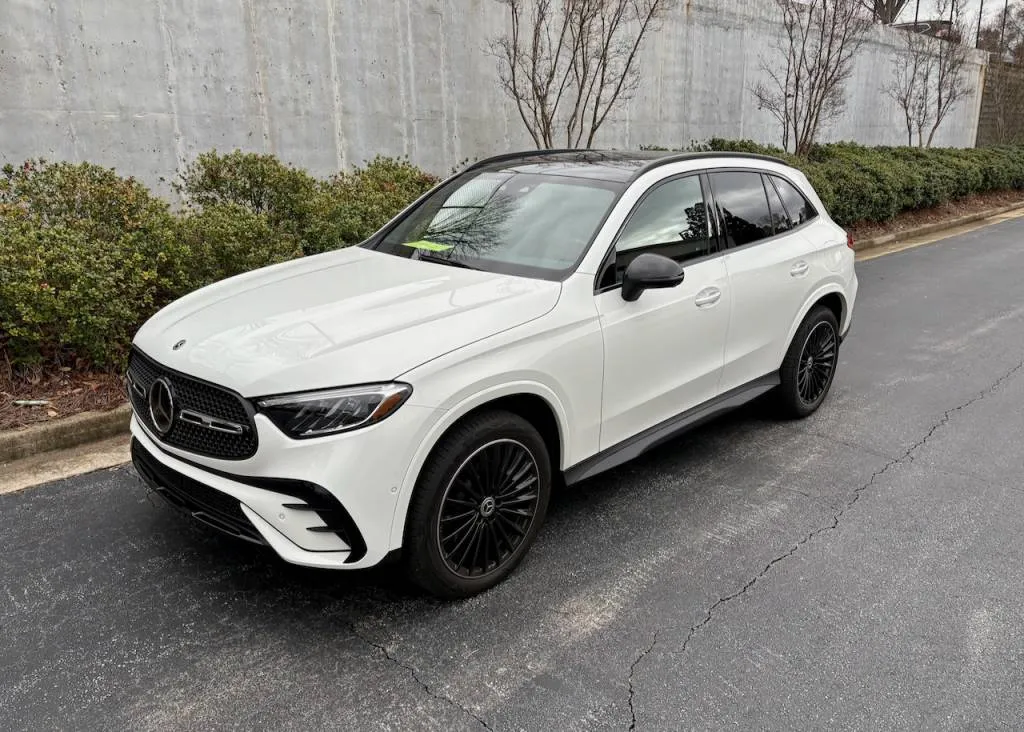
2025 Mercedes-Benz GLC 350e plug-in hybrid test drive review
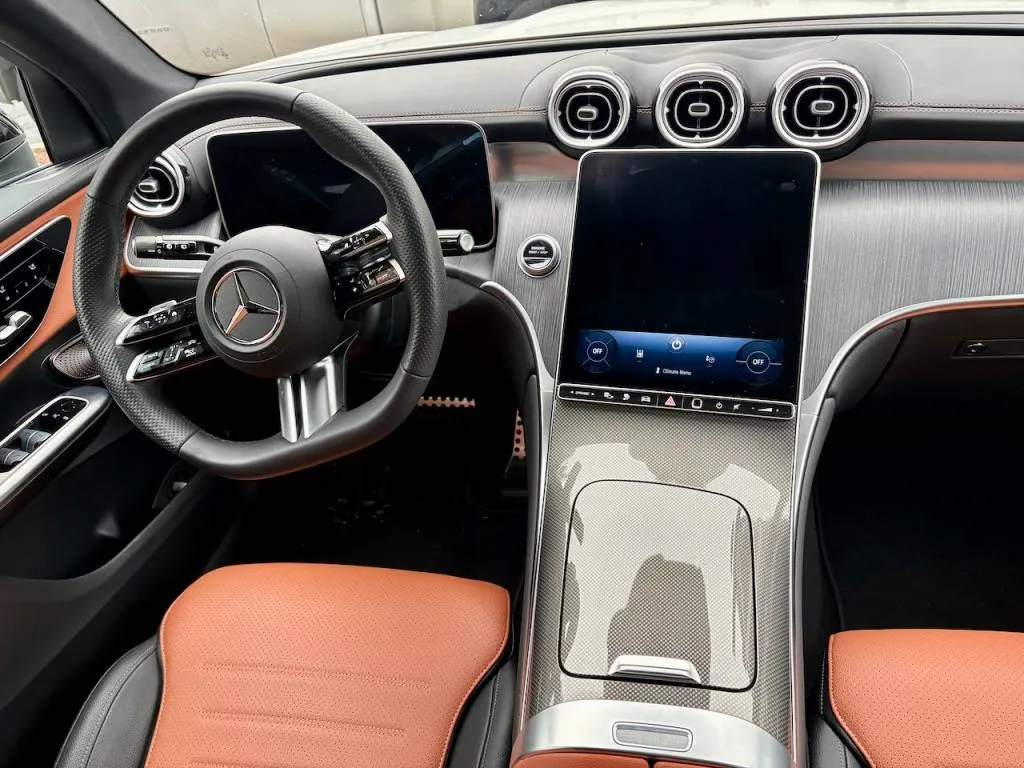
2025 Mercedes-Benz GLC 350e plug-in hybrid test drive review
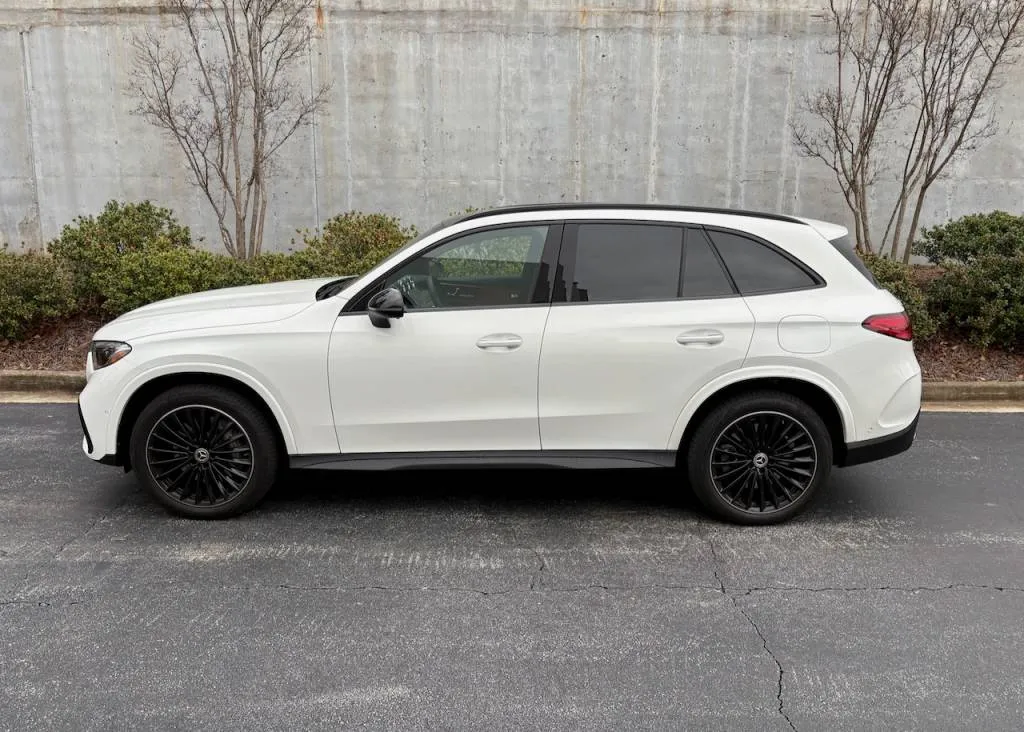
2025 Mercedes-Benz GLC 350e plug-in hybrid test drive review
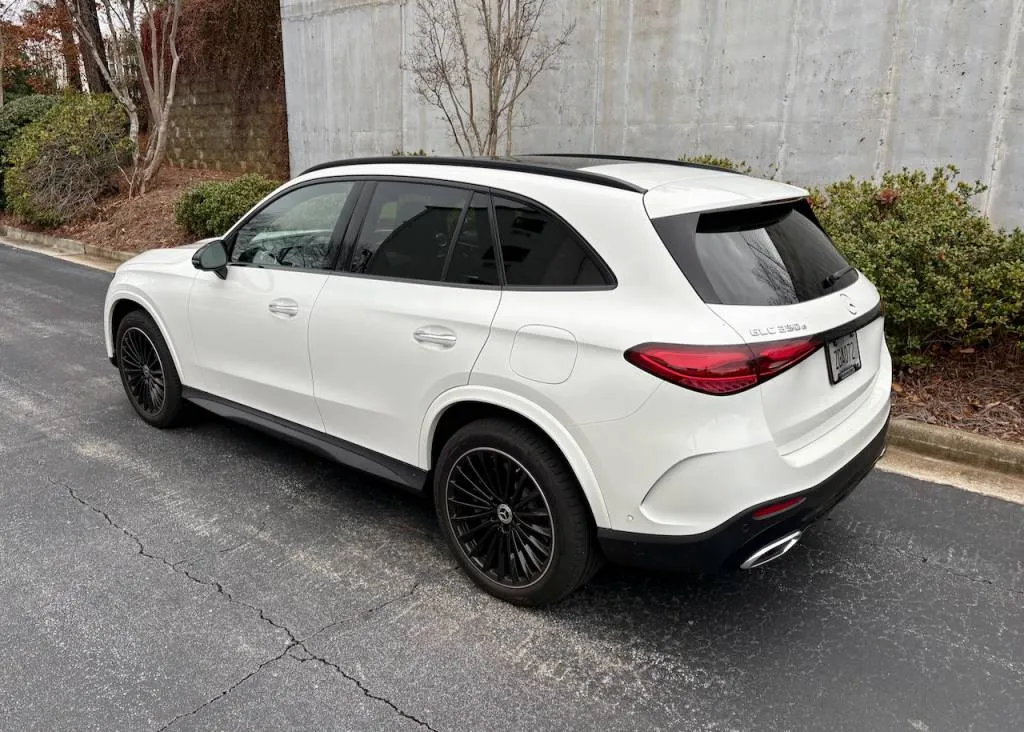
2025 Mercedes-Benz GLC 350e plug-in hybrid test drive review
2025 Mercedes-Benz GLC-Class looks, space, and stuff
Mercedes repotted the GLC in the 2023 model year, resculpting its handsome shape that leans more wagon than SUV. Also sold as a more rakish Coupe model, the GLC has a stunning interior, with a digital tombstone at its center that asserts the interface’s prominence against a river of matte wood or metallic trim. Studded by squircular air vents and glammed up with metallic trim in every direction, it lights up the ground as you enter, flickers to life when its start button gets pressed, and responds to almost every beck and call when you send out the voice command, “Hey Mercedes.” If there’s an element of modern tech missing from its wrapper, I wasn’t able to identify it over a four-day road trip.
The GLC’s 113.1-inch wheelbase sets out a footprint that permits lots of interior room, with snug front 16-way power seats that have been designed around a person slightly smaller than me. After a few hours of darting out to an exurban retreat and back, the driver seat made itself known at my hips with a dull ache. On one break, I sat in the three-person bench, which could house two of me and my size-12 feet and short-leg, long-torso body with ease. Everything I’d brought on my road trip—coolers, overnight bag, backpack—fit easily into the 21.9 cubic-foot cargo area, too. Folded down, the rear seatbacks expand that total to 52.6 cubic feet.
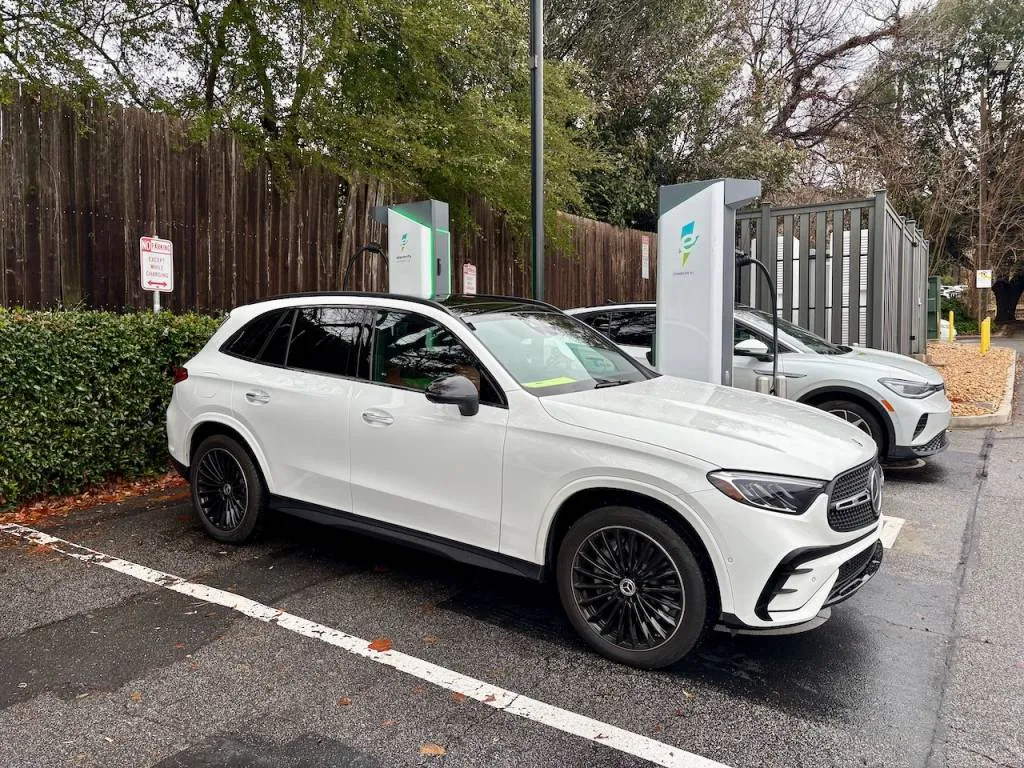
2025 Mercedes-Benz GLC 350e plug-in hybrid test drive review
How much does the 2025 Mercedes-Benz GLC-Class cost?
With a price that falls between the Kia EV9 and a base Rivian R1S, the $61,050 GLC 350e plug-in hybrid came witha charging cable I wasn’t pressed to use, as well as its 11.9-inch touchscreen, wireless Apple CarPlay and Android Auto, and touch-sensitive steering wheel controls that I grew more accustomed to over time.
Mercedes sells another plug-in GLC—the 671-hp AMG GLC 63 S E Performance, which lays on the power to earn its initialism. Both join a lineup of PHEVs that also includes the plug-in hybrid edition of the larger GLE-Class that arrived for the 2024 model year.
In the future, it’s likely we’ll see the EQC electric SUV in the U.S. in 2025, after Mercedes pulled back from plans to bring it here in 2019. These stopgap models will help the automaker as it pivots and delays its EV sales targets, as the politics surrounding electrified vehicles shift with every passing minute.
Most of us would rather own the all-electric models that may come to pass, but over this weekend of driving I was able to calculate exactly how the GLC plug-in might work. It’s the same line we harp on with every PHEV review: You must plug it in for it to make sense.
This time it comes with the caveat: You must plug it in at home for it to make sense.
What you plug into better have something more like the $0.17/kwh price most Atlantans pay for electricity. That calculates out to something more like $4.50 for a full, putative 62-mile charge.
That scenario is entirely possible—if not likely—with a home charger that’s used religiously. Out here in the bougie burbs, plug-in drivers who don’t have their own garage setup will remain at the mercy of our strip-mall overlords—and, at times, by overpriced, undermaintained charging situations created by legal settlements. At those prices, the espresso should be free.
Read the full article here



